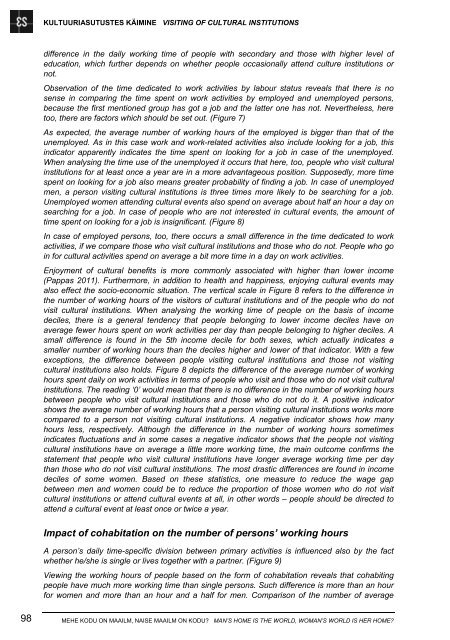MEHE KODU ON MAAILM, NAISE MAAILM ON KODU? - Tartu Ãlikool
MEHE KODU ON MAAILM, NAISE MAAILM ON KODU? - Tartu Ãlikool
MEHE KODU ON MAAILM, NAISE MAAILM ON KODU? - Tartu Ãlikool
Create successful ePaper yourself
Turn your PDF publications into a flip-book with our unique Google optimized e-Paper software.
KULTUURIASUTUSTES KÄIMINE VISITING OF CULTURAL INSTITUTI<strong>ON</strong>S<br />
difference in the daily working time of people with secondary and those with higher level of<br />
education, which further depends on whether people occasionally attend culture institutions or<br />
not.<br />
Observation of the time dedicated to work activities by labour status reveals that there is no<br />
sense in comparing the time spent on work activities by employed and unemployed persons,<br />
because the first mentioned group has got a job and the latter one has not. Nevertheless, here<br />
too, there are factors which should be set out. (Figure 7)<br />
As expected, the average number of working hours of the employed is bigger than that of the<br />
unemployed. As in this case work and work-related activities also include looking for a job, this<br />
indicator apparently indicates the time spent on looking for a job in case of the unemployed.<br />
When analysing the time use of the unemployed it occurs that here, too, people who visit cultural<br />
institutions for at least once a year are in a more advantageous position. Supposedly, more time<br />
spent on looking for a job also means greater probability of finding a job. In case of unemployed<br />
men, a person visiting cultural institutions is three times more likely to be searching for a job.<br />
Unemployed women attending cultural events also spend on average about half an hour a day on<br />
searching for a job. In case of people who are not interested in cultural events, the amount of<br />
time spent on looking for a job is insignificant. (Figure 8)<br />
In case of employed persons, too, there occurs a small difference in the time dedicated to work<br />
activities, if we compare those who visit cultural institutions and those who do not. People who go<br />
in for cultural activities spend on average a bit more time in a day on work activities.<br />
Enjoyment of cultural benefits is more commonly associated with higher than lower income<br />
(Pappas 2011). Furthermore, in addition to health and happiness, enjoying cultural events may<br />
also effect the socio-economic situation. The vertical scale in Figure 8 refers to the difference in<br />
the number of working hours of the visitors of cultural institutions and of the people who do not<br />
visit cultural institutions. When analysing the working time of people on the basis of income<br />
deciles, there is a general tendency that people belonging to lower income deciles have on<br />
average fewer hours spent on work activities per day than people belonging to higher deciles. A<br />
small difference is found in the 5th income decile for both sexes, which actually indicates a<br />
smaller number of working hours than the deciles higher and lower of that indicator. With a few<br />
exceptions, the difference between people visiting cultural institutions and those not visiting<br />
cultural institutions also holds. Figure 8 depicts the difference of the average number of working<br />
hours spent daily on work activities in terms of people who visit and those who do not visit cultural<br />
institutions. The reading ‘0’ would mean that there is no difference in the number of working hours<br />
between people who visit cultural institutions and those who do not do it. A positive indicator<br />
shows the average number of working hours that a person visiting cultural institutions works more<br />
compared to a person not visiting cultural institutions. A negative indicator shows how many<br />
hours less, respectively. Although the difference in the number of working hours sometimes<br />
indicates fluctuations and in some cases a negative indicator shows that the people not visiting<br />
cultural institutions have on average a little more working time, the main outcome confirms the<br />
statement that people who visit cultural institutions have longer average working time per day<br />
than those who do not visit cultural institutions. The most drastic differences are found in income<br />
deciles of some women. Based on these statistics, one measure to reduce the wage gap<br />
between men and women could be to reduce the proportion of those women who do not visit<br />
cultural institutions or attend cultural events at all, in other words – people should be directed to<br />
attend a cultural event at least once or twice a year.<br />
Impact of cohabitation on the number of persons’ working hours<br />
A person’s daily time-specific division between primary activities is influenced also by the fact<br />
whether he/she is single or lives together with a partner. (Figure 9)<br />
Viewing the working hours of people based on the form of cohabitation reveals that cohabiting<br />
people have much more working time than single persons. Such difference is more than an hour<br />
for women and more than an hour and a half for men. Comparison of the number of average<br />
98<br />
<strong>MEHE</strong> <strong>KODU</strong> <strong>ON</strong> <strong>MAAILM</strong>, <strong>NAISE</strong> <strong>MAAILM</strong> <strong>ON</strong> <strong>KODU</strong>? MAN’S HOME IS THE WORLD, WOMAN’S WORLD IS HER HOME?

















